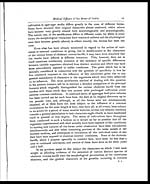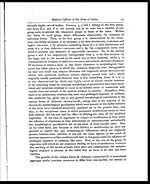Medicine - Institutions > Army health reports and medical documents > Scientific memoirs by medical officers of the Army of India > Part VIII, 1894 > 1 - Results of continued study of various forms of comma-bacilli occuring in Calcutta
(18) Page 12
Download files
Individual page:
Thumbnail gallery: Grid view | List view

12
Scientific Memoirs by
gelatine and agar-agar media, in bouillon and on potatoes, and in recurring to
the question I propose to consider the same points in detail.
Considering how subject to modification the morphological features of
schizomycetes are under the influence of external conditions, it is somewhat
surprising to find how comparatively seldom any conspicuous changes of form
have manifested themselves in the various choleraic comma-bacilli as a result
of continued cultivation in neutralised agar-agar media. In the greater number
of instances the original morphological features have sustained no appreciable
alteration, and where alteration has occurred it has generally been limited in
amount. Figures 1, 2, and 3 of Plate IV are copies of camera-lucida drawings
of preparations of the elements of forms α, β and γ in a series of cultures
which were made exactly three years subsequent to the period at which the
original cultivations were obtained. The drawings were executed by a Mussal-
man draftsman, who is totally ignorant of the subject at issue, they have been
in no way tampered with since they left his hands, and he received no instruc-
tions whilst making them, so that they are practically of photographic value. In
spite of this, it will be seen that the elements present conspicuous peculiarities
in each instance, and that these remain the same as those which I originally
indicated as distinctive for the forms dealt with, the elements of α being
distinguished by their bluntness and deficient curvature, those of β by their
shortness, thickness and high curvature and those of γ by their slenderness and
curvature. Another feature persistently characteristic of the elements of form α
and which was very conspicuous in the preparation, the highly aggregant ten.
dency of the elements, is not illustrated in the drawing. Healthy growths of
forms ε, ζ, θ, λ and μ have consistently been composed of elements which have
retained their original morphological peculiarities practically unchanged, and it is
really only in the case of forms ι and η that any appreciable permanent alteration
seems to have occurred. In regard to their morphological characters some
forms of choleraic bacilli appear to be more stable than others. Forms α, β
γ, ε, ζ, θ, λ, and μ have retained their morphological characters throughout
practically unaltered, or, in other words, they have been unaffected save in so
far as regards mere minor variations in size or degree of curvature of their ele-
ments by any of the minor variations in the exact constitution of the nutrient
medium which must inevitably attend any prolonged series of cultures. Other
forms, such as η and ι, do not appear to be liable to sudden variations in char-
acter connected with such variations in their media, but have shown a tendency
to gradual modification tending towards the permanent assumption of a new
form, and still others such as κ, ν and ξ have throughout been characterised by
instability of form. The morphologically stable forms are referable to two dis-
tinct groups, in the former of which the elements have the form of relatively
elongated rods of varying degrees of curvature or in some cases almost wholly
devoid of curvature, whilst in the other they consist of relatively short and
Set display mode to: Large image | Zoom image | Transcription
Images and transcriptions on this page, including medium image downloads, may be used under the Creative Commons Attribution 4.0 International Licence unless otherwise stated. ![]()
| Permanent URL | https://digital.nls.uk/75002056 |
|---|
| Shelfmark | IP/QB.10 |
|---|---|
| Additional NLS resources: | |




